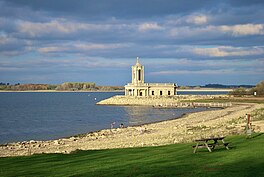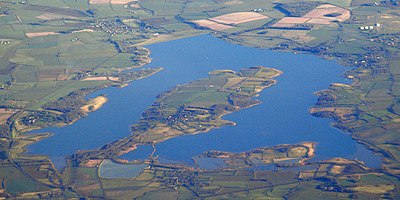geo.wikisort.org - Reservoir
Rutland Water is a reservoir in Rutland, England, east of Rutland's county town, Oakham. It is filled by pumping from the River Nene and River Welland, and provides water to the East Midlands. By surface area it is the largest reservoir in England, but its capacity is exceeded by that of Kielder Water in Northumberland. Its maximum depth is 33m (108 ft).
| Rutland Water | |
|---|---|
 St Matthew's Church, Normanton on the water's edge | |
| Location | Rutland |
| Coordinates | 52°40′N 0°40′W |
| Lake type | Reservoir |
| Basin countries | England |
| Managing agency | Anglian Water |
| Designation | Site of Special Scientific Interest |
| Built | 1971–1975 |
| First flooded | 1976 |
| Surface area | 10.86 square kilometres (4.19 sq mi) |
| Water volume | 124 million cubic metres (4.4×109 cu ft) |
Ramsar Wetland | |
| Designated | 14 October 1991 |
| Reference no. | 533[1] |



Set in 3,100 acres (13 km2) of countryside, it has a 23-mile (37 km) perimeter track, (17-mile (27 km) excluding Hambleton Peninsula) for walking or cycling.[2] Since the water is drawn upon when needed, the relative areas of land and water vary a little, but the flatter parts of the lake margin are enclosed by banks so that the wetland nature reserve is maintained (grid reference SK886073).
A 1,555 hectare area of lake and shore is a biological Site of Special Scientific Interest,[3][4] a Special Protection Area under the European Union Directive on the Conservation of Wild Birds[5] and Nature Conservation Review site.[6] An area of 1,333 hectares is a Ramsar internationally important wetland site,[7] and 393 hectares at the western end is managed by the Leicestershire and Rutland Wildlife Trust.[8]
Construction
The reservoir's construction, by damming the Gwash valley near Empingham, was completed in 1975. During its construction it was known as Empingham Reservoir. It flooded six or seven square kilometres of the Gwash valley as well as the side valley, at the head of which lies Oakham. Nether Hambleton and most of Middle Hambleton were demolished and their wells were plugged as part of the ground preparation. Their neighbouring village of Upper Hambleton survived, and now sits on the Hambleton Peninsula. The Gwash makes a net input to the lake but its flow downstream is maintained. Most of the stored water is extracted from the River Welland at grid reference TF017060, between Tinwell and Stamford, and from the River Nene upstream from Peterborough, a city which is a major user of the water.
Because much of the valley is clay, material for the dam was extracted from pits dug within the area that would be subsequently flooded. The clay dam is 115 feet (35 m) high, and around 1,300 yards (1,200 m) long. At its base, it is up to 890 yards (810 m) wide, and the finished structure has been landscaped to blend in with the environment, even when viewed from Empingham, the nearest village.[9]
Rutland Water contains a limnological tower for study of the reservoir's ecological conditions.[10]
Community
Upper Hambleton and the remnant of Middle Hambleton, including the Old Hall, are together now known simply as Hambleton and are to be found on a long peninsula in the middle of the lake, land that was formerly a ridge between the two valleys in which the lake now lies. The few houses of Normanton avoided flooding although its church did not. The lower part of the building was supported against water damage so that its upper part could be used to present the story of the construction of the reservoir to the public. Some funerary monuments from it can be seen at Edenham church, Lincolnshire.
Recreation
The reservoir is used not just for water storage, but is a popular sports centre – as well as water sports such as sailing[11] visitors enjoy fishing, walking and cycling along a 25 miles (40 km) perimeter track. A pleasure cruiser, the Rutland Belle, carries people around the lake. Birdwatching brings visitors from far afield. The former butterfly centre at Sykes Lane has been turned into Bugtopia – The Zoo.
Wildlife
Large areas of wetland (as well as several small woods) at the western end of the lake form a nature reserve, managed by Leicestershire and Rutland Wildlife Trust. The area is designated a Special Protection Area of international importance for its wintering populations of gadwall (some 4% of this species’ European population) and shoveler. It is home to the Anglian Water Bird Watching Centre. Every August, the centre is the venue for the British Birdwatching Fair. Other birds found here include lapwing, coot, goldeneye, tufted duck, pochard, teal, wigeon, cormorant, great crested grebe, little grebe and, most notably, osprey, which were re-introduced to the area during 1996,[12] including one called "Mr Rutland". In 2021 there were 26 ospreys in the area of Rutland Water.[13]
The lake is stocked with brown trout and rainbow trout, but there is a large head of coarse fish populated by water pumped in from the River Welland and River Nene, species include roach, bream, pike, zander, perch, eel, wels catfish and carp.
Ichthyosaur
In early 2021 an ichthyosaur fossil was discovered during the routine draining of a lagoon at the reservoir. A Temnodontosaurus with a skeleton measuring about 10 metres in length and a skull weighing about a tonne, is the largest and most complete fossil of its kind found in the UK.[14][15]
Visitor centres
The Anglian Water Birdwatching Centre, located in Egleton, features a gift shop operated by the Leicestershire and Rutland Wildlife Trust and a shop selling binoculars and telescopes. The centre includes the Rutland Environmental Education Centre, exhibits, and windows overlooking the wetlands.
The Lyndon Visitor Centre is located on the reserve's south shore. There are exhibits, bird viewing windows, trails and hides.
References
- "Rutland Water". Ramsar Sites Information Service. Retrieved 25 April 2018.
- Rutland Cycling. Cycle Map Rutland Water (Map).
- "Designated Sites View: Rutland Water". Sites of Special Scientific Interest. Natural England. Retrieved 13 September 2017.
- "Map of Rutland Water". Sites of Special Scientific Interest. Natural England. Retrieved 13 September 2017.
- "Designated Sites View: Rutland Water". Special Protection Area. Natural England. Retrieved 11 August 2017.
- "Rutland Water citation" (PDF). Sites of Special Scientific Interest. Natural England. Retrieved 11 August 2017.
- "Designated Sites View: Rutland Water". Ramsar Site. Natural England. Retrieved 11 August 2017.
- "Rutland Water". Leicestershire and Rutland Wildlife Trust. Retrieved 11 June 2022.
- "The Heritage of Rutland Water" (PDF). Rutland Local History & Record Society. p. 5. Archived from the original (PDF) on 19 March 2012. Retrieved 17 March 2011.
- Ferguson, A.J.D.; Harper, D.M. (1 March 1982). "Rutland water phytoplankton: the development of an asset or a nuisance?". Hydrobiologia. 88 (1): 117–133. doi:10.1007/BF00008304. ISSN 1573-5117.
- "Rutland Sailing Club". Retrieved 28 October 2010.
- "Rutland Osprey Project". Retrieved 6 March 2012.
- "Ospreys return from extinction in England and Wales". Sky News. 5 August 2021. Retrieved 15 May 2022.
- Black, Riley (10 January 2022). "Giant 'sea monster' fossil is one of the largest of its kind". National Geographic. Retrieved 10 January 2022.
- Fisher, Jonah (10 January 2022). "Huge fossilised 'sea dragon' found in Rutland reservoir". BBC News. Retrieved 10 January 2022.
External links
- Rutland Water Nature Reserve
- Official Tourism Guide to Rutland Water
- Special Protection Area data
- Rutland Sailing Club
- Images of Rutland Water
- Image gallery of photos taken around Rutland Water
На других языках
[de] Rutland Water
Rutland Water ist ein Stausee im Zentrum der englischen Unitary Authority Rutland. Mit einer Fläche von 12,6 km² ist er der flächenmäßig größte Stausee Englands, im Wasservolumen wird er nur noch vom Kielder Water in Northumberland übertroffen.- [en] Rutland Water
[fr] Rutland Water
Rutland Water est un lac artificiel dans le comté de Rutland, près d'Oakham. Construit en 1976, il est l'un des plus grands lacs artificiels d'Europe, le plus grand du Royaume-Uni par sa superficie (10,86 km2) et le second après Kielder Water par sa capacité (124 000 000 m3). Le site est également désigné site d'intérêt scientifique particulier depuis 1984[1] et site Ramsar depuis 1991[2].[ru] Ратленд-Уотер
Ратленд-Уотер (англ. Rutland Water) — водохранилище в английском графстве Ратленд. Площадь — 10 км². Ёмкость — 120 млн м³. Наряду с Келдер-Уотер в Нортумберленде является одним из крупнейших водохранилищ Англии.Другой контент может иметь иную лицензию. Перед использованием материалов сайта WikiSort.org внимательно изучите правила лицензирования конкретных элементов наполнения сайта.
WikiSort.org - проект по пересортировке и дополнению контента Википедии

